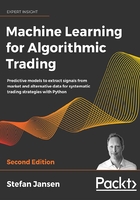
Alpha factors in practice – from data to signals
Alpha factors are transformations of raw data that aim to predict asset price movements. They are designed to capture risks that drive asset returns. A factor may combine one or several inputs, but outputs a single value for each asset, every time the strategy evaluates the factor to obtain a signal. Trade decisions may rely on relative factor values across assets or patterns for a single asset.
The design, evaluation, and combination of alpha factors are critical steps during the research phase of the algorithmic trading strategy workflow, which is displayed in Figure 4.1:

Figure 4.1: Alpha factor research and execution workflow
This chapter focuses on the research phase; the next chapter covers the execution phase. The remainder of this book will then focus on how to leverage ML to learn new factors from data and effectively aggregate the signals from multiple alpha factors.
Alpha factors are transformations of market, fundamental, and alternative data that contain predictive signals. Some factors describe fundamental, economy-wide variables such as growth, inflation, volatility, productivity, and demographic risk. Other factors represent investment styles, such as value or growth, and momentum investing that can be traded and are thus priced by the market. There are also factors that explain price movements based on the economics or institutional setting of financial markets, or investor behavior, including known biases of this behavior.
The economic theory behind factors can be rational so that factors have high returns over the long run to compensate for their low returns during bad times. It can also be behavioral, where factor risk premiums result from the possibly biased, or not entirely rational, behavior of agents that is not arbitraged away.
There is a constant search for and discovery of new factors that may better capture known or reflect new drivers of returns. Jason Hsu, the co-founder of Research Affiliates, which manages close to $200 billion, identified some 250 factors that had been published with empirical evidence in reputable journals by 2015. He estimated that this number was likely to increase by 40 factors per year.
To avoid false discoveries and ensure a factor delivers consistent results, it should have a meaningful economic intuition based on the various established factor categories like momentum, value, volatility, or quality and their rationales, which we'll outline in the next section. This makes it more plausible that the factor reflects risks for which the market would compensate.
Alpha factors result from transforming raw market, fundamental, or alternative data using simple arithmetic, such as absolute or relative changes of a variable over time, ratios between data series, or aggregations over a time window like a simple or exponential moving average. They also include metrics that have emerged from the technical analysis of price and volume patterns, such as the relative strength index of demand versus supply and numerous metrics familiar from the fundamental analysis of securities. Kakushadze (2016) lists the formulas for 101 alpha factors, 80 percent of which were used in production at the WorldQuant hedge fund at the time of writing.
Historically, trading strategies applied simple ranking heuristics, value thresholds, or quantile cutoffs to one or several alpha factors computed across multiple securities in the investment universe. Examples include the value investing approach popularized in one of Warren Buffet's favorite books, Security Analysis, by Graham and Dodd (1934), which relies on metrics like the book-to-market ratio.
Modern research into alpha factors that predict above-market returns has been led by Eugene Fama (who won the 2013 Nobel Prize in Economics) and Kenneth French, who provided evidence on the size and value factors (1993). This work led to the three- and five-factor models, which we will discuss in Chapter 7, Linear Models – From Risk Factors to Return Forecasts, using daily data on factor returns provided by the authors on their website. An excellent, more recent, overview of modern factor investing has been written by Andrew Ang (2014), who heads this discipline at BlackRock, which manages close to $7 trillion.
As we will see throughout this book, ML has proven quite effective in learning to extract signals directly from a more perse and much larger set of input data without using prescribed formulas. As we will also see, however, alpha factors remain useful inputs for an ML model that combines their information content in a more optimal way than manually set rules.
As a result, algorithmic trading strategies today leverage a large number of signals, many of which may be weak inpidually but can yield reliable predictions when combined with other model-driven or traditional factors by an ML algorithm.